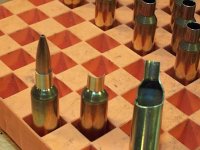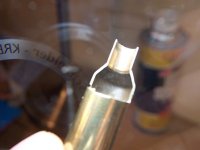'Mornin' alinwa.

At the risk of derailing this topic....let's take it a step further, okay?
In your estimation, how much excessive headspace ('cuz that's effectively what I'm creating when I shove the shoulders back) will cause case head thinning and the case head seperation that we're constantly warned of? In other words..how much 'shove back' is too much?
We can also start a new thread on this if you'd like.
Talk later....headed to work and then to see the dentist.

EVEnin' Al

To do it one ONE SHOT takes either very old and brittle brass coupled with .005-.006 hs, or even more clearance, so much head play that they'll barely fire. Otherwise it takes repeated firings. I've seen both cases but the one-shot situation is not common. The last one around here that blew the head off a FACTORY round was a decent Marlin bolt action rifle which the older gentleman fired with 40 yr old ammo. The ammunition cases had been fairly green when he wiped them off with polish......the box was rotted.....THAT sort of old......... Busted two cases right off. I checked the headspace right at .007....... New brass will stretch a LOOONG ways. Remember that big ol' case started out as a little brass button that just got hammered repeatedly until it was squished out to size and looked like a case.
The other problem exists from reloaders who "set their die to bottom out on the shellholder" because that's what the book said. EVERY TIME you set the shoulder back you're shoving brass out through the neck and EVERY TIME it "fixes" itself by slamming forward, locking there and then streetching the brass back to bottom out on the boltface. ((((The usual "fix" for this is to grease cases. Greasing cases works OK some of the time for short BR/PPC type cases but the cases never all fireform exactly the same because they're not all GREASED exactly the same. Folks who do this are forever culling cases which feel different or seat different. Furthermore, this is the actual reason for canted or out of square caseheads, THIS is what The Skipper was fighting. I suppose if you greased, wiped the chamber, greased, wiped etc you may avoid inconsistencies due to buildup but WHY???))))) Now, for the casual factory reloader this whole thing is an insoluble problem. The factory dies and factory chambers are always completely mismatched and the "solution" is over-sizing, accomplished by making resize dies which size clear back to factory spec. Without going into all of the problems generated, suffice it to say that this is also why all of the newer reloading manuals tell you to look for the grainy ring which indicates incipient head separation. Any rifle system which requires you to repeatedly trim brass to length HAS EXCESS HEADSPACE. Period. The dies are set too low, the fittages are wrong or the chamber is stretching. The newer Hornady manuals explain this really well with actual photos showing clearly the thinning brass at the caseweb/body junction. This junction is where ALL of the brass comes from. I did a quickie websearch for pix of incipient casehead separation pix and came up dry but I did find this Bellm site which in a quick scan seemed to have accurate information.
http://www.bellmtcs.com/store/index.php?cid=172
For FACTORY stuff you're just stuck with whatever your particular matchup will allow.......probably 3-5 reloads and then chuck 'em. For the factory guys reading this, IF YOU'RE TRIMMING OFF BRASS you're headed down a wrong road. Trim once, NO MORE THAN twice, and hurl the brass into the landfill most postehastily.
Now, back to the .002 or more setback for initial fireform..... Doing it once or twice ISN'T DANGEROUS but it results in inferior brass. (((I know, I know, "If my gun shot any better it'd be illegal!"

))) Really square brass WILL AGG BETTER. And cases will last literally forever with ZERO trimming and they will always shoot well if you so choose. I've got BR cases which have been fired so many times that the flashholes are eroded and they've never been re-trimmed to length. I'll often fire a set of cases more times during one load workup than many folks fire them in a barrel's life. My normal routine is to grab up five cases and shoot/load/shoot/load them 8-30 times. In one afternoon I'll run the same cases thru the dies/rifle until I'm done. Sometimes I'll keep those 5 cases for several barrels........maybe 50-80 firings on them. And I never worry about culling through match cases for fit, they ALL resize and seat and chamber alike. My latest 6X47 project I had to make up 160 cases for 600yd comp. I lost none except for stupid. I culled them for casewall runout and stuck them in my box. They're on their 4th go-round and you couldn't tell them apart for feel. Grab any one at random and it will (does) measure out with the others.
I set all of my chambers short.
I bump every shoulder to crushfit just for fireform.
I set my dies to headspace at .0000 (This often requires readjustment for temperature changes, true zero....I'm good at it.) Absolute zero is unnecessary, you can get by with a half a thou and rely on case compression for resizing, never sliding the shoulder. Sometimes even .001 but in this case I suggest you lube only the base of the cases, let the shoulder stay locked and compress the sidewalls of the case. Or, (I'm not ADVOCATING this

) if your die is hardened and you're real tool handy and measure handy and into saving steps....... set it up to use Butch's for your sizing lube. I save my clean wet patches and use them to wipe my necks clean, AND as resize lube! I've got cases that've been sized 30-40 times and the Butch's hasn't thinned or weakened the necks as far as I can tell. Of course I only do this when shooting/loading/shooting/loading in a controlled setting. In other circumstances I use clean patches (Ohhh the WASTE

) to wipe the necks and apply the Butch's. I also am a big believer in die wax....... THIN......
Soooo, in your case there's ZERO danger of separation. You're using less than factory clearance on new brass....... but try it my way and your holes will get even rounder

seriously......
These thirties are freakin' SCAREY!!! Fireforming for my 30X47 I actually had to call Jim Borden I was so excited. He made me a couple barrels for an HBR gun I'm building on a 700, an action he fixed up for a guy's hunting rifle. Rem action with the mag-box still in it. Dang thing will still function as a hunting rifle! I bought it with a beasty heavy McMillan A-2 stock on it. He made me barrels but the other parts aren't ready and I wanted to shoot it. I screwed this weinie liddle Hart barrel on and bolted everything together.....gun looked and felt like it was popping a wheelie. I crammed some pillows into a front rest and balanced that ungainly "Tactical" stock into place.....felt like I had to bungee it down to keep it from tipping over......
I grabbed me some BIB's and a load from my other HBR chambering (developed 14yrs ago on a .308 case minus .200) and layed all over the (boresighted) weapon and shot a hole. It was over 3" and up 7". Ok, so's I'm on paper.
I fired again, nuttin.
??
I fired again
NUTTIN!
!!
So I pulled over a half a hole and made a jelly bean.......
Hokey SMOKE Bullwinkle!!!!!
It's never let up....... I fired it 30 times to make 30 cases, but it's rightful stock is setting in the barrel vise with the sides sawed off and hunks of carbon fiber all fuzzing out.....
ACT'rally....... On this gun I had Kiff make my reamer to match my 14yr-old chamber and Neil Jones die....... I actually FIREFORM the cases with shottygun powder so's I can trim them up for real. The firings in the actual 30X47 were just to "pop the necks out" after neckturning

For FUN

This gun WITH AN A-2 STOCK is so fun I've let two other guys shoot it just to show off.
Kiff's a frickin genius die-maker measurer-upper........
al




